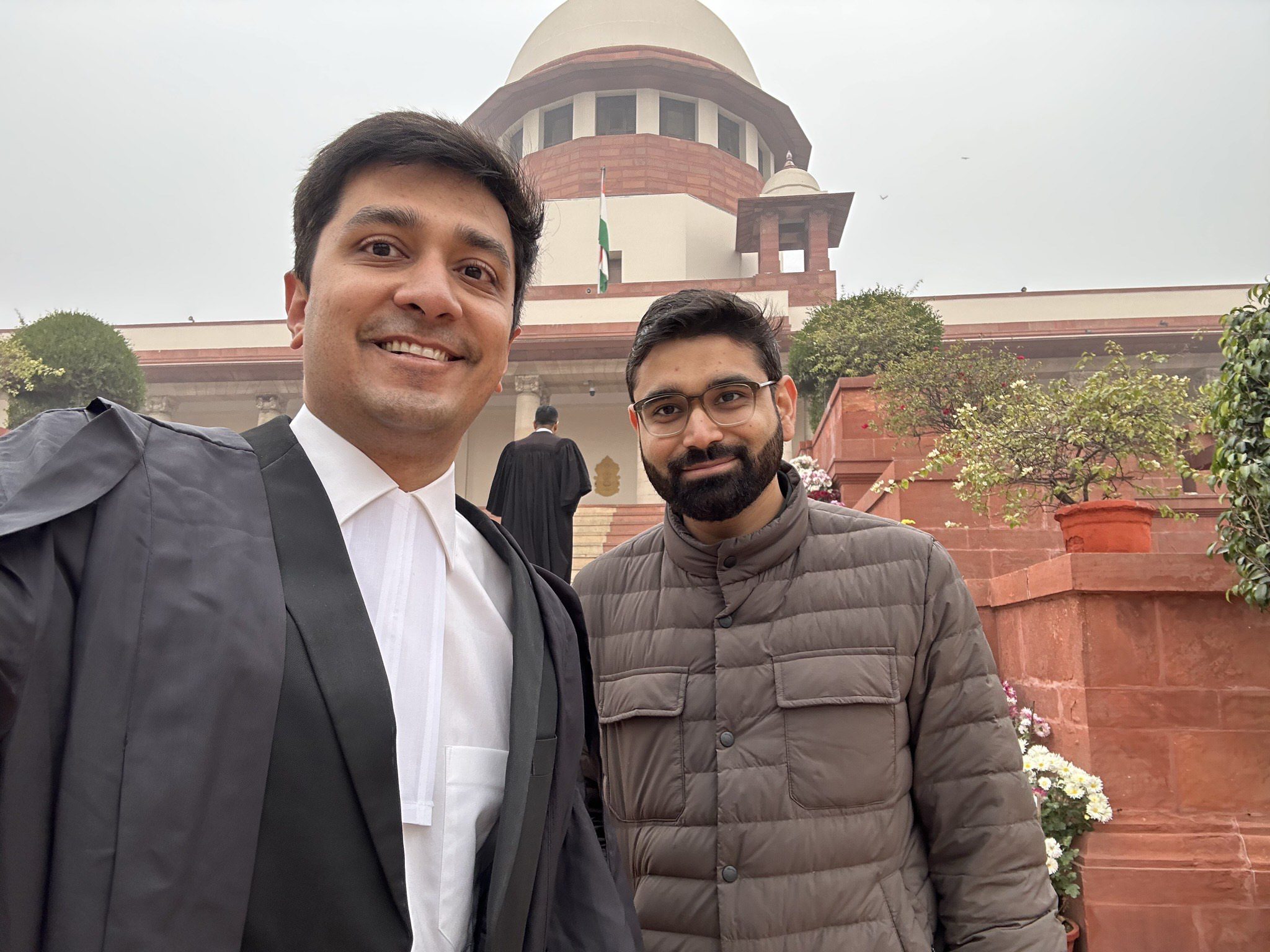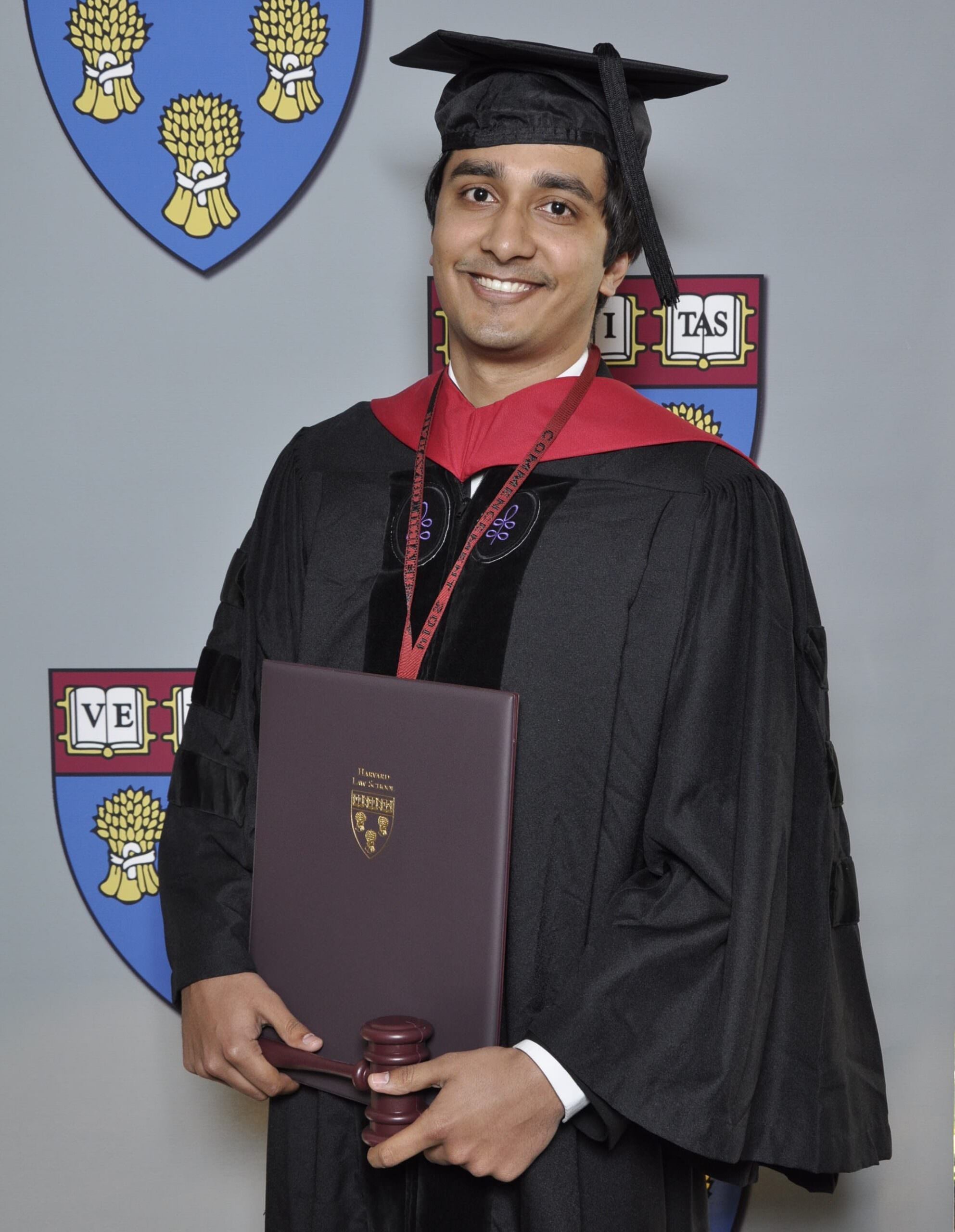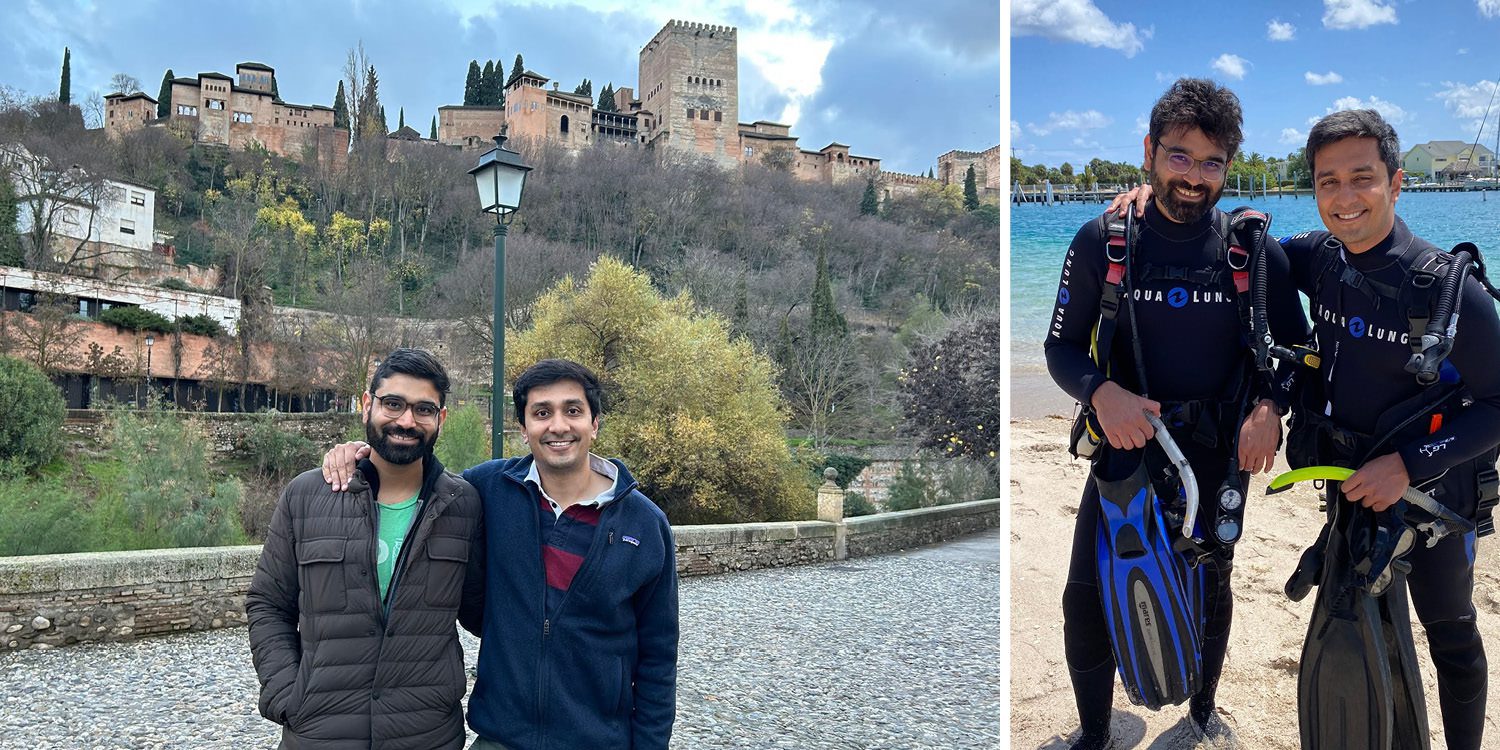
Utkarsh Saxena, HLS ’14 and HKS ’20, and his partner Ananya Kotia in front of India’s Supreme Court building.
This week India’s Supreme Court began hearing arguments for a historic same-sex marriage petition. Current Indian law does not recognize same-sex marriage; rather, couples obtain rights and benefits solely as cohabitators. Now Utkarsh Saxena, Harvard Law School ’14 and Harvard Kennedy School ’20 alumnus, is challenging this Special Marriage Act. He and his partner, Ananya Kotia, filed a petition with India’s Supreme Court calling for the legalization of same-sex marriage. As the case unfolds in the Supreme Court, we spoke with Saxena about the ruling’s potential implications.
Mittal Institute: Can you share a little bit about your experience growing up as a queer man in India – what are some of India’s current LGBTQ+ rights, and how have you seen that change or evolve over the years?
Utkarsh Saxena: Growing up as a queer kid in India was very difficult and lonely and depressing. It was the late 90s/early 2000s, and it was still a criminal offence in the country. In fact, it was a criminal offence until 2018. But besides just the law being against us, it was also incredibly difficult because society was so phobic and hateful. Any depictions of queer people in popular culture or cinema were always ridiculing and mocking them – caricaturing them, stereotyping them.

Utkarsh Saxena, HLS ’14 and HKS ’20.
There was also a constant fear of abandonment in that I would lose my family and friends if they found out about me and heard about my true identity. And that’s why I tried very hard to suppress it, so I struggled with a lot of shame and just more existential questions. I wondered if I would ever be happy in life; if I would ever be accepted; what was the point of working so hard? It just felt so useless because there was just no happiness in my destiny, which just made it very difficult. I must have been depressed. I must have been struggling with deep mental health issues, but had no vocabulary to articulate them. Mental health was not a big conversation back in the day. I didn’t have any support systems. I couldn’t speak to my teachers, my counselors, my classmates, my friends, my families. And I just don’t understand how I dealt with it. Frankly, when I look back and reflect on that time that by myself, I was dealing and battling something so difficult at such a young and fragile age. So it was very challenging, to say the least.
But things have changed over the years, both legally and socially. Legally, India became one of the first countries to identify transgender as a separate gender in 2014. In 2017, there was a nine judge bench in a very important constitutional case in which privacy was identified as a fundamental right in the Indian Constitution – in which I also appeared as a lawyer – and that ruling became the bedrock and paved the way for future changes.
In 2018, homosexuality was decriminalized and all of these changes obviously gave us more hope and optimism; it also changed hearts and minds, as these legal changes were unfolding. Society was also changing. We’ve seen better and more sensitive depictions of queer stories and queer lives in Bollywood, on TV shows, etc. When you take the stigma of the law out of the picture and give these stories some oxygen and sunlight, they can flourish and find representation in popular culture. So things have definitely improved a lot, which is why, even though I never imagined that in my lifetime any of these rights would have been possible, I actually feel comfortable as an openly gay man to be filing these petitions and seeking equal rights in such a public way.
Mittal Institute: You and your partner, Ananya Kotia, have lived together for the past 14 years. What was the catalyst for you, in terms of filing this petition?
Utkarsh Saxena: I think we both felt that we’d been together for so long that we’re in a very good place personally and emotionally. We didn’t feel as fragile and vulnerable. We’d been fortunate to complete our education and have some professional opportunities in life that gave us some security. And we felt that nothing or no one could hurt us, even if they wanted to use our identities against us when we took the stance so publicly. So I think personally, we just felt we were ready in terms of law and society.

Saxena and Kotia.
As I said, there always is a catch-up game. Sometimes the law is ahead of society, sometimes the society is ahead of the law. But either way, we’ve been noticing very positive developments, especially over the last decade that made us believe that this is the right time and the natural next step after privacy and decriminalization. It’s the natural next step to seek the same equal rights that other citizens in society have — for us to be full and complete citizens and participants in this democracy in a constitutional republic.
It’s the natural next step to seek the same equal rights that other citizens in society have — for us to be full and complete citizens and participants in this democracy in a constitutional republic.
Mittal Institute: Can you share more about the specifics of the petition? If passed, what rights would it grant same-sex couples?
Utkarsh Saxena: There are a range of petitions that have been filed seeking very different things. The petition that Kotia and I filed is seeking changes to the Special Marriage Act, which is the secular law of the land that allows people who wish to get married outside their faith to do so. You also have personal laws like the Hindu Marriage Act or the Muslim Marriage Act. We haven’t challenged those laws, but there are other petitioners who have challenged those laws.
We have two broad claims. One, we are saying that any gendered words in the act (for example, husband, wife, bride, bridegroom, man, woman) should now be interpreted as persons in a way that’s agnostic of gender or sexual orientation. So any two persons, irrespective of their gender or sexual orientation or how they identify, should be allowed to be married as long as they’re two consenting adults and clear the age requirements for marriage – no other limitations should be imposed. That’s our first broad claim.
The second claim is that within Indian marriage and the Special Marriage Act, there are some provisions that require you to go to a marriage officer to express your intent to be married, upon which the marriage officer puts up your photographs on a notice board in the local office for 30 days in case anybody in society at large wishes to object to that marriage. And only after you clear that period and there are no objections, are you allowed to get married. We are asking for this legal architecture, which we call the “notice and objection regime,” to also be struck down because it really hurts vulnerable minorities. It puts them up for scrutiny and exposes them when they’re already targets and ostracized in society. That actually makes the access to marriage a lot more difficult. And these hurdles that make access to marriage more difficult should be done away with. These are the two broad claims that we are seeking in our petition.
Hurdles that make access to marriage more difficult should be done away with.
Mittal Institute: What will it mean to you, to be appearing in court for something so deeply personal, yet something that would have such widespread civil rights impacts?
Utkarsh Saxena: It means a lot. It’s quite profound to realize that I am a petitioner seeking these rights. And then I’m also appearing as a lawyer on behalf of my partner and myself. So it’s a big moment for me personally, but also professionally. It does make it more difficult because it’s often said that as a lawyer, you shouldn’t be too emotionally attached to your brief, in order to be truly objective and to do a good job. And of course, there are moments when I hear offensive arguments being made by the government in court that I feel more triggered by than if they were an argument made against a client that I was appearing on behalf of. So I think it can be difficult, but it’s good to also be working with a team of lawyers who are all very supportive. That enables me to try looking at this in as just as any other brief as much as possible, even though that’s not always easy to do.
Mittal Institute: How can our community follow along on the case and ruling?
Utkarsh Saxena: Because this is a five judge constitution bench, this case is going to be telecast and publicized on the Supreme Court website, and it will also be picked up by YouTube and other platforms and telecast there. So you can basically go into any of these platforms and search for Supreme Court same sex marriage, and you will get hits where you can follow this.
There will also be a lot of news reporting by Indian news platforms, which you can also follow. I think this is going to get a lot of attention in the coming weeks as the final arguments go on. We don’t know when the judgment is going to be out, but if the hearings proceed uninterrupted over the next few weeks and end before court summer vacation, which starts around mid-May, then the court is probably going to take the summer vacation to deliberate and write about the judgment. And it’s probably going to be out sometime after court reopens in July or August.
